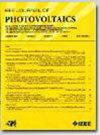24.4%效率前结硅异质结太阳能电池损耗分析及局部接触机会
IF 2.5
3区 工程技术
Q3 ENERGY & FUELS
引用次数: 0
摘要
硅异质结(SHJ)太阳能电池最近在各种器件架构和工业尺寸(>200 cm2)晶圆上达到了25%以上的功率转换效率。然而,为了准确评估效率潜力和进一步发展该技术,确定高性能设备配置并对其进行详细分析仍然至关重要。在这项工作中,我们首先概述了我们基于n型晶圆的实验室规模(4 cm2)前结电池,其认证效率为24.44%。我们报告了与之前报道的设备(即更薄的前端硅层和低折射率后反射器)相比的关键改进。然后,我们提出了详细的功率损耗分析,表明尽管最近有所改进,但前层堆栈中的寄生吸收仍然是损耗的主要来源。因此,我们研究了接下来的方法来规避这种损失,例如高度吸收的前层的定位和切换到后结架构。通过数值计算,我们表明,如果p型接触实现相当低的接触电阻率(2),则前结结构可以从接触局部化中获得0.3%abs的效率增益。通过同时切换到后结架构并定位具有接触电阻率的n型接触,可以实现更大的效率增益(2的接触电阻率高达0.7%abs)。最后,我们提出了一种简单的制造方法,使用阴影掩模在前端层沉积期间进行接触定位,并演示了具有局部接触的概念验证电池。本文章由计算机程序翻译,如有差异,请以英文原文为准。
Loss Analysis of a 24.4%-Efficient Front-Junction Silicon Heterojunction Solar Cell and Opportunity for Localized Contacts
Silicon heterojunction (SHJ) solar cells have recently reached power conversion efficiencies above 25% with various device architectures and with industrial size (>200 cm
2
) wafers. Yet, for an accurate assessment of the efficiency potential and further development of the technology, the identification of high-performing device configurations, and their detailed analysis is still vital. In this work, we first present an overview of our lab-scale (4 cm
2
) front-junction cells based on n-type wafers with a 24.44% certified efficiency. We report on the key improvements compared with our previously reported devices (i.e., thinner front-side silicon layers and low refractive index rear reflector). Then, we present a detailed power loss analysis, showing that parasitic absorption in the front layer-stack remains a major source of loss despite the recent improvements. Accordingly, we investigate next approaches to circumvent this loss, such as localization of the highly absorbing front layers and switching to a rear-junction architecture. Using numerical calculations, we show that the front-junction configuration can benefit from an efficiency gain of 0.3%
abs
with contact localization if considerably low contact resistivities (<20>2
) are realized for the p-type contact. Even larger gain in efficiency can be achieved by simultaneously switching to a rear-junction architecture and localizing the n-type contact with contact resistivities that are relatively accessible with the current state of the art (up to 0.7%
abs
gain for <20>2
). Finally, we propose a simple fabrication method for contact localization using shadow masks during depositions of the front-side layers and demonstrate proof-of-concept cells with localized contacts.
求助全文
通过发布文献求助,成功后即可免费获取论文全文。
去求助
来源期刊

IEEE Journal of Photovoltaics
ENERGY & FUELS-MATERIALS SCIENCE, MULTIDISCIPLINARY
CiteScore
7.00
自引率
10.00%
发文量
206
期刊介绍:
The IEEE Journal of Photovoltaics is a peer-reviewed, archival publication reporting original and significant research results that advance the field of photovoltaics (PV). The PV field is diverse in its science base ranging from semiconductor and PV device physics to optics and the materials sciences. The journal publishes articles that connect this science base to PV science and technology. The intent is to publish original research results that are of primary interest to the photovoltaic specialist. The scope of the IEEE J. Photovoltaics incorporates: fundamentals and new concepts of PV conversion, including those based on nanostructured materials, low-dimensional physics, multiple charge generation, up/down converters, thermophotovoltaics, hot-carrier effects, plasmonics, metamorphic materials, luminescent concentrators, and rectennas; Si-based PV, including new cell designs, crystalline and non-crystalline Si, passivation, characterization and Si crystal growth; polycrystalline, amorphous and crystalline thin-film solar cell materials, including PV structures and solar cells based on II-VI, chalcopyrite, Si and other thin film absorbers; III-V PV materials, heterostructures, multijunction devices and concentrator PV; optics for light trapping, reflection control and concentration; organic PV including polymer, hybrid and dye sensitized solar cells; space PV including cell materials and PV devices, defects and reliability, environmental effects and protective materials; PV modeling and characterization methods; and other aspects of PV, including modules, power conditioning, inverters, balance-of-systems components, monitoring, analyses and simulations, and supporting PV module standards and measurements. Tutorial and review papers on these subjects are also published and occasionally special issues are published to treat particular areas in more depth and breadth.
 求助内容:
求助内容: 应助结果提醒方式:
应助结果提醒方式:


